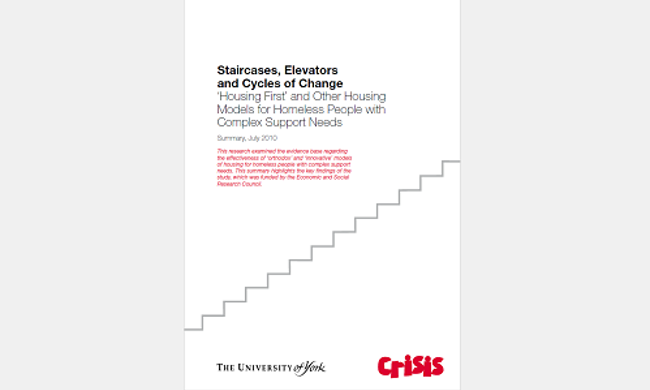Staircases, Elevators and Cycles of Change (2010)
06.03.2010
This report reviews the evidence base regarding the effectiveness of both 'orthodox' and 'innovative' models of supported housing for homeless people with complex support needs. The study assessed existing evidence regarding what 'works' for homeless people with complex support needs and drew together 'lessons learned' in other developed countries.
Key findings
- The prevailing approach to housing homeless people in the US, Europe and Australia can be described as ‘linear’ in nature. This essentially involves ‘progressing’ homeless people through a series of separate residential services.
- It is founded on a ‘treatment first’ philosophy, with homeless people typically only placed into ‘normal’ housing when they exhibit evidence of ‘housing readiness’ (e.g., basic living skills, sobriety, commitment to engage in treatment).
- Linear models have been criticised in some contexts because of their high attrition rates (i.e., the loss of clients between stages) and emerging evidence of much better housing outcomes associated with an alternative, ‘housing first’, model.
- The Housing First model bypasses transitional accommodation by placing the most vulnerable homeless people directly from the street into independent tenancies with tailored support, without insisting that they engage in treatment.
- Housing First projects tend to report better housing retention than linear programmes. Evaluations in the US indicate that 80% of chronically homeless Housing First clients sustained housing over a two year period, for example.
- Such outcomes fundamentally challenge widespread assumptions that chronically homeless people with co-occurring mental health problems and/or substance dependencies are incapable of maintaining an independent tenancy.
- In the UK, the linear model is implemented more flexibly than elsewhere, but a ‘treatment first’ philosophy still prevails – with most support agencies requiring evidence of ‘housing readiness’ before placing clients into independent settled accommodation.
- The view that existing hostels do not necessarily ‘work’ for this group is increasingly common in the UK. Some recent developments have elements of ‘Housing First-ness’, but these are outnumbered by new specialist transitional housing schemes.
- Some stakeholders doubt that Housing First outcomes reported in the US would be reproduced to the same extent in the UK, but most believe the model would be a valuable complement to existing provision, especially for the ‘hardest to reach’ and most ‘service resistant’ rough sleepers.
- The 2012 target to end rough sleeping in London, and similar albeit less formalised ambitions to reduce street homelessness elsewhere, represent a key window of opportunity for innovation in the development of effective solutions for this highly vulnerable group.
- Going forward, there is a clear need for further research with respect to the effectiveness of different interventions for homeless people with complex support needs.
Reference
Johnsen, S. and Teixeira, L. (2010) ‘Housing First’ and Other Housing Models for Homeless People with Complex Support Needs. London: Crisis.
Further reading
There is more about Housing First in our policy section on housing models and types.

